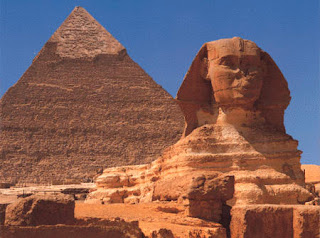There are currently about 110 known pyramids in Egypt, many in a state of great neglect and almost unrecognizable. Some were built as burial places for kings and others for queens. A pyramid also may have represented a stairway for the king to ascend to heaven.Another possibility is that it was a symbol of the primordial mound in which he was born the sun god / creator.
How the Egyptians managed the complex organization of work and the physical movement of large stone blocks is still under debate.Pyramid construction may have involved the ramps being erected around the pyramid. Blocks of stone would have been pulled on sleds and ramps dismantled later. It is believed that most of the work for the construction of the pyramids would have come from farmers who were on hand during the flood season, when the Nile River flooded and farmland was underwater. In addition, it would be the ideal time for the shipping of large blocks of stone from their quarries to the pyramid sites.
The first pyramid was the Pyramid of King Djoser of the Old Kingdom's Third Dynasty over 4,600 years ago. The pyramid (right) was the largest structure ever built at Saqqara, the necropolis that overlooked the ancient capital of Memphis. Its construction was initially in the form of a low mastaba tomb upon which extra levels were added gradually to give it a look similar steps.
How the Egyptians managed the complex organization of work and the physical movement of large stone blocks is still under debate.Pyramid construction may have involved the ramps being erected around the pyramid. Blocks of stone would have been pulled on sleds and ramps dismantled later. It is believed that most of the work for the construction of the pyramids would have come from farmers who were on hand during the flood season, when the Nile River flooded and farmland was underwater. In addition, it would be the ideal time for the shipping of large blocks of stone from their quarries to the pyramid sites.
The first pyramid was the Pyramid of King Djoser of the Old Kingdom's Third Dynasty over 4,600 years ago. The pyramid (right) was the largest structure ever built at Saqqara, the necropolis that overlooked the ancient capital of Memphis. Its construction was initially in the form of a low mastaba tomb upon which extra levels were added gradually to give it a look similar steps.













